This year SNH awarded £5.8 million from its Green Infrastructure Fund to seven projects that will improve local green space in some of the most deprived, urban areas in Scotland. Match funding from other sources will result in a total investment of £19.6 million.
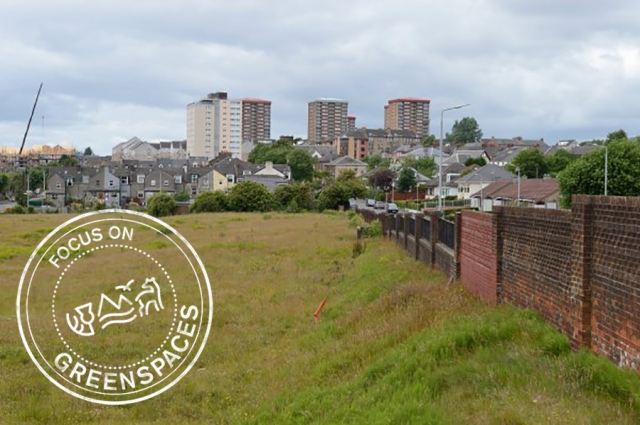
Green infrastructure project site at Clydebank © Lorne Gill/SNH
Five of the seven new projects are in west Central Scotland at Possilpark, Easterhouse, Clydebank, Castlemilk & Fernhill, and Cardonald. The other two projects are at Middlefield in Aberdeen and Aberdeen Royal Infirmary. The projects were chosen because of their good green infrastructure design, their strong links to neighbouring communities and the range of benefits they will bring to the areas where they are based.
Ian Ross, our chairman at the time, said: “We’re delighted to help fund these projects and look forward to working with our partners to deliver them. Green infrastructure makes such a big impact on a community: attracting businesses to an area, improving physical and mental health, reducing flood risk, and improving biodiversity. The Green Infrastructure Fund provides a unique opportunity to create better places for people and wildlife on an unprecedented scale across urban Scotland. It’s a wonderful chance for us to work in areas where it is most needed.”
1. Canal and North Gateway (Glasgow City Council)
The Canal and North Gateway project will enhance greenspace along the canal corridor between Firhill and Port Dundas, including creation of a local nature reserve and an innovative water management solution based around the Forth & Clyde Canal. The physical improvements are supported by the creation of two new project officer posts to deliver community engagement based around the new LNR. The Clay Pits LNR project will convert a currently derelict site into a nature reserve, with a new gateway building created out of the existing Old Basin House at Applecross Street, along with improved entrance points, paths, viewpoints, interpretation and signage. The North Glasgow Integrated Water Management System (NGIWM) provides the surface water drainage solution for the regeneration of key vacant and derelict sites including Sighthill, Dundashill, Hamiltonhill and Cowlairs. It will develop blue-green fingers extending out from the canal into a number of water management areas, which serve regeneration areas for housing, education and business, and provide an innovative water management solution for the area, making use of dynamic water management of the canal and sustainable urban drainage systems (SUDS).
Total Project Cost = £8.1m of which the contribution from European Regional Development Fund (ERDF) is £1.6m.
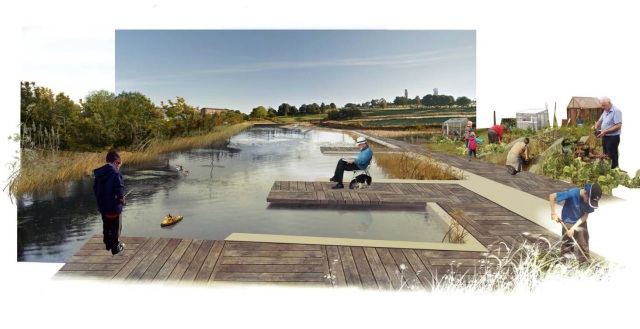
Canal and North Gateway, visualisation. AECOM
2. Greater Easterhouse (Glasgow City Council)
The project will deliver large-scale green infrastructure enhancement within Greater Easterhouse, giving local people links to a wide network of green space including the Seven Lochs area, as well as benefit a nationally important population of water voles. The project involves the creation of new and improved open space through the delivery of an integrated green and blue network in two focus areas – Cranhill/Ruchazie and Blairtummock which will create green finger connections to the Seven Lochs Wetland Area. It will transform over 29ha of land within an area which has been identified as one of Scotland’s most socially and economically deprived areas, carried out in partnership with the Seven Loch’s Partners, local communities and stakeholders and key agencies.
Total Project Cost = £4.19m of which the contribution from ERDF is £1.25m.
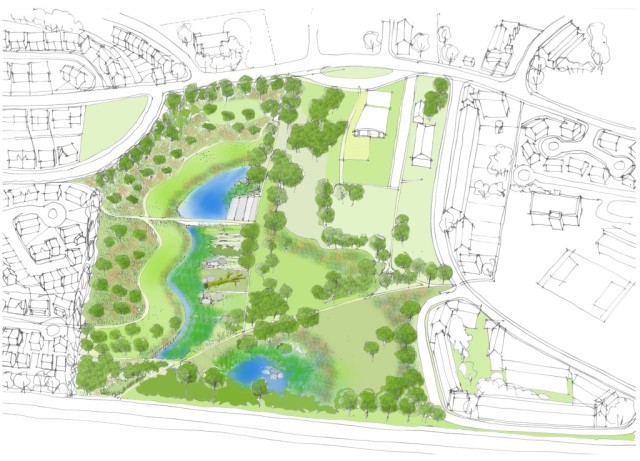
Easterhouse – sketch of Cranhill. ERZ
3. Community Greenspace, Clydebank (West Dunbartonshire Council)
This project will redevelop the currently inaccessible and severely contaminated former site of the St Eunan’s Primary School in the Linnvale and Drumry areas of Clydebank. The site itself is not within one of the 15% Scottish Index of Multiple Deprivation (SIMD) areas, but it is surrounded by neighbouring communities which fall within either the 5% or 10% category. The Council had identified the site for housing, but this was ruled out by the contamination found on the site. They have consulted the community on an alternative use, and a biodiversity park is the preferred option. The contaminated area will be capped and then top-soiled, and then a new, multi-functional Community Green Space would be created, including wildflower meadows, raised bed allotments, an outdoor classroom and natural play areas for children, an outdoor gym, a sensory garden, and interpretation and references to the heritage of Clydebank. In addition, new pedestrian routes will be provided through the site which will encourage more active travel. A ‘Friends of’ and Community Allotments group will also be established.
Total Project Cost = £1.55m of which the contribution from ERDF is £620k.
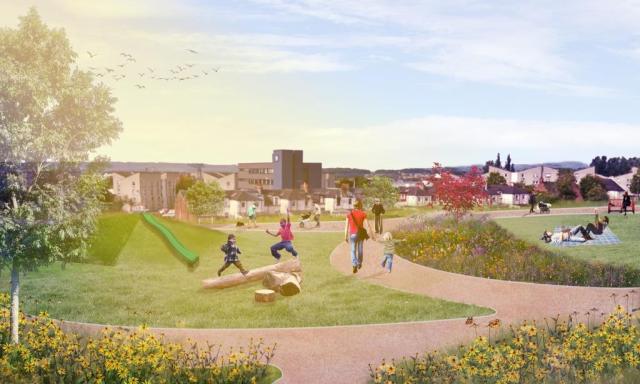
Clydebank community park, visualisation. West Dunbartonshire Council
4. Blairbeth Urban Park (South Lanarkshire Council)
Blairbeth is the site of a former golf course which went out of business in 2015. It is located on the south edge of Glasgow, next to the communities of Castlemilk and Fernhill. A majority of areas within these communities are the most deprived 5% according to the SIMD, and with scores for health and education which are within the most deprived 1% for Scotland. While there is a country park (Cathkin Braes) to the south of the site, overall these communities lack available greenspace. Since closing, the golf course has fallen into a derelict state and is a magnet for anti-social behaviour such as vandalism and fly-tipping.
The park will provide over 20 hectares of semi-natural, managed green space, creating a series of paths and cycle-ways, improving accessibility to what was previously a private green space. Seating, a trim trail and a community growing area will be provided, and there will be a wide range of activities and events, engagement with local schools and volunteering opportunities, all of which will enable positive community use. The biodiversity of the site will be enhanced by creating a series of natural meadows connected by woodland corridors, attracting native species back to the area that had been driven away during the site’s intensive management as a golf course. The management and maintenance of the wetland area will create an integrated natural habitat, reducing flood risk and creating more natural processes that will allow the watercourse to better support local ecosystems. A ‘Friends of’ group will be established to assist with future care of the park.
Total Project Cost = £871k of which the contribution from ERDF is £349k.
5. Halfway Community Park (Southside Housing Association, Glasgow)
Southside Housing Association are transforming an underused, difficult to access and unattractive open space at Moss Heights in the south of Glasgow into a new community park. This complements work the Association have done to improve the high rise buildings in the area, by also improving their surrounding green space. The project will improve biodiversity, provide space for active and passive recreation and improve public safety and access for all through landscaping, tree and shrub planting, construction of a community growing space, a green gym, a natural play area and removing cars from the area in front of the high rise flats. It will also offer a range of opportunities for people to get involved with the site, from community growing and learning to cycle, to volunteer tree care and gardening apprenticeships.
The project was developed with the community, including drop in events and door to door survey, and a ‘Friends of’ group has now been established. A range of voluntary organisations active in the area have expressed interest in the potential of the community park for volunteering, for training and for community events. The area is one of multiple deprivation (high unemployment, low income, poor health, low educational attainment) and has a high proportion of people from ethnic minorities. The site sits within the most deprived 5% SIMD datazones, and the datazones within the surrounding communities of Cardonald and Craigton are almost all within the most deprived 15%.
Total Project Cost = £2.2m of which the contribution from ERDF is £901k.

Southside Housing Association visualisation. ERZ
6. Middlefield (Aberdeen City Council)
Middlefield is a housing estate in north-west Aberdeen, ranked amongst the 10-20% most deprived areas in the SIMD. The area has a range of social issues including a high proportion of young families and economic migrants, low incomes, poor school attendance, higher than average physical and mental ill health and reduced life expectancy. Living Streets, a UK charity, conducted a community street audit in 2016 which identified several reasons as to why people in the area were disengaged with using existing green infrastructure. The main negative aspect was the lack of connectivity of the community with what they perceived as vast empty space and the perceived lack of safety by the children and elderly. Individual issues raised included footpaths which were in need of repair or submerged under water during flooding, anti-social behaviour related to vandalism and motorbike use, and poor signage.
Aberdeen City Council have used these results to work with residents to encourage community buy-in and shape the details of this project. The project therefore represents the needs and wants of the community. It includes plans to create safer and more accessible footpaths, greater cohesion between community facilities and increased diversity of activities in the park. Community ownership is central to the project, which is vital for encouraging the community to use the park. The project will convert the current area of low amenity grass into a matrix of habitats that include trees, wildflower meadows, grassland and the de-culverting of the burn that runs through the site. The latter will also reduce the flood risk in the Middlefield area and downstream. There will be new footpath and cycling routes across the site, as well as exercise trails and formal and informal play areas.
Total Project Cost = £1.1m of which the contribution from ERDF is £427k.
7. Foresterhill Campus, Aberdeen (NHS Grampian)
The Foresterhill campus in Aberdeen is the largest hospital complex in Europe and is home to the city’s main hospitals plus the medical school and medical science departments of the University of Aberdeen. The site has developed incrementally over many decades without a clear masterplan for its overall layout and design. As a result, it has limited green space, no clear pedestrian or cycling routes through the site and extensive areas of impermeable surfacing, with large scale parking areas that accelerate surface water runoff and contribute to significant downstream flooding in central Aberdeen. This project aims to begin to address these deficiencies by creating a new ‘destination green space’ in the western part of the site (close to a new health centre), with tree planting, new paths to create a better network across the site, and water storage basins and linear water storage features to reduce run-off. The proposal fits with wider aspirations to improve the environment of the overall NHS estate.
The project is distinct from others which have applied for GI funding, in that its focus is on benefits to users of the health and university facilities on site who are drawn from across Aberdeen and Grampian region. These do, of course, include people from disadvantaged communities. The site isn’t immediately adjacent to a <15% SIMD community though, with the closest being Mastrick some 0.8 miles away. However, the improved green space and access routes across the site will benefit surrounding communities, including Mastrick.
Total Project Cost = £1.6m of which the ERDF Contribution is £660k.
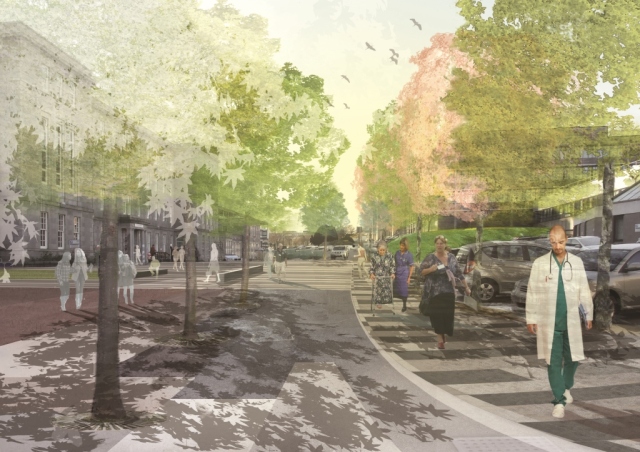
NHS Grampian – Foresterhill campus visualisation. ERZ
You can read more about our projects on the individual project pages here.

You must be logged in to post a comment.